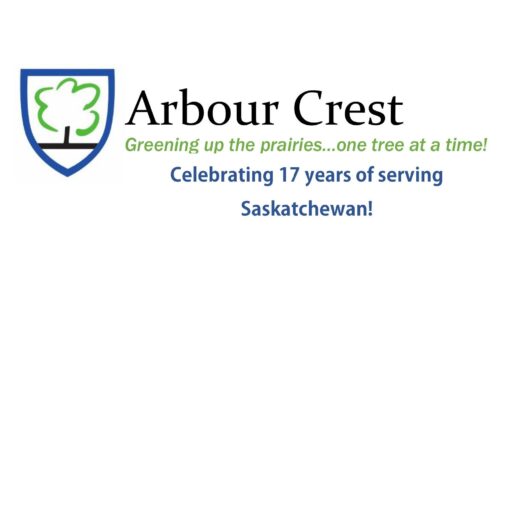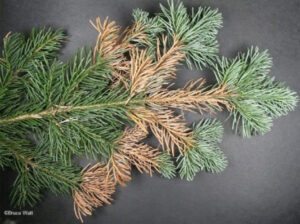 | Needle Cast
-sing/early summer new needles are green (at the tips) and the older needles turn brown to purple.
-Discolored leaves fall off in the fall
-Little to no needles near the trunk and the tree looks thin/see through.
-Damage starts low and moves up the tree. | -Maintain good air circulation by removing dead branches from the inside of the tree.
-Mulch under the trees to help retain moisture and stop weed/grass competition stress.
-Make sure that irrigation is not spraying onto the needles.
-Well timed fungicide spray. First in early summer, then second one 2-4 weeks after. |
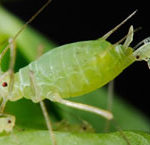 | Aphids
-Generally black/gray and yellow/green, less than 3mm with long legs and antennae
-Typically found on broadleaved trees and shrubs with blotchy dead leaf tissue
-Repeated infestations can cause eventual branch dieback and early leaf drop | -Multiple life stages can be present and they occur in large colonies on new growth
-Systemic insecticides, sprays (for adults) and bioinsecticides
-Multiple life stages may require multiple applications |
 | Apple Maggot
-Adults of this insect are about 5mm long and have a dot on their thorax and a black banding like an “F” on their wings
-White-yellowish worm like larva with not so noticeable head that feed on the apples causing brown spots with tunnels through fleshy tissue
-Found in primarily Apples and Hawthorns | -One generation per season
-Adults emerge in early July before laying eggs under Apple skin
-Larva will overwinter in soil
-Foliar sprays to control adults, no systemics suggested for edible species
-Traps and decoys for egg laying females
-IPM plan is suggested for this pest |
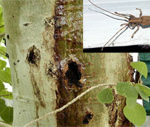 | Aspen (Poplar) Borer
-Adults approx. 1″ long and are dark grey with small orange spots on their wings
-Larvae white, about 1 1/4″ long, legless, and yellow-white in color
-Heartwood boring insect creating cavities
-Frass (wood dust, cuttings) at base of tree | -Emerge June until August, and lay eggs in slits they have cut in the bark
-Egglaying females are most likely to be attracted to opengrown and single trees in partial to full sun
-Systemic insecticides, sprays (for feeding adults) |
 | Birch Leafminer
-Adult resembles a black wasp (about 3mm long), larva are flat and white (5-7mm long)
-Blotchy dead leaf tissue.
-Repeated infestations can cause eventual branch dieback | -Eggs hatch early June, two generations per year
– Larvae overwinter in soil/fallen debris
-Systemic insecticides, sprays (for adults), bio-insecticides also available |
 | Blister/Gall Mite
-They are not noticeable with naked eye
-Feed/hide beneath leaves causing a blister to form
-Reduce the amount of useful leaf surface in broad leaf trees and some conifers
-Eventual branch dieback possible | -Larvae overwinter in soil/ fallen debris and egg hatch early June, two generations per year
-Systemic insecticides, sprays (for adults), bio-insecticides also available.
-Typically do not require treatment however can pose significant health risks if left untreated (long term) |
 | Bronze Birch Borer
-Adults 1⁄4″ to 1⁄2″ long dark colored beetles , larvae up to one inch long when fully grown, pale white with a flattened body and two pincerlike tails at back
-Secluded branch dieback from boring D shaped holes in trunk and limbs
-Kills vascular system reducing nutrient transport | -They pupate in spring and start to emerge as adults in early June
-Larval stage is the most destructive and difficult to control
-Systemic insecticides, sprays (bio-insecticides available) |
 | Cottony Ash Psyllid
-First noticed here in Saskatoon in 2006.
-This insect will only affect Black and Manchurian Ash
-This insect hatches early in the spring (Early May) as the buds are starting to crack
-Psyllid nymphs feed on the leaves of your tree and cause curling of the leaf edge | -Implementing an IPM strategy is the only way to protect your tree from this insect
-Multiple life stages may require multiple applications |
 | Emerald Ash Borer
-Emerald Ash Borer (EAB) is an invasive insect originating from Asia and is reported to have arrived in Winnipeg 2017
-No sightings in Saskatoon yet but we are prepared.
-Adults emerging in May to June will feed on foliage creating C-shaped cuts in leaflets | -Implementing an IPM strategy is the only way to protect your tree from this insect
-Multiple life stages may require multiple applications |
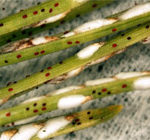 | Pine Needle Scale
-Nymphs are tiny yellow flat crawlers, adults females are oval wingless insects up to 3mm long
-Usually noticable as a white dotted cover over tree or shrub
-Sucks juices from needles reducing vigor and health leaving behind yellow and brown needles | -Egg hatch occurs in the spring
-Females settle and secrete waxy scale like coverings over their bodies and produce a sac of eggs under the scale
-Systemic insecticides, sprays in spring durring crawling phase, pruning |
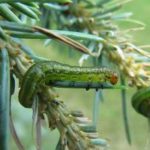 | Yellow-headed Spruce Sawfly
-Larvae look like caterpillars and are normally grayish-green and have a light stripe down the back, a light stripe along each side followed by a dark green stripe
-Full grown larvae are about 1″ long | -If the population levels are consistently high in your area, treatments are suggested to bring the population down to an acceptable threshold
-Most treatments take place in June (or prior to) when the trees are leaved and larvae are in their destructive stage |
 | Spruce Spider Mite
-Scarcely visible to naked eye and appear greyish with eight legs (some species red)
-With high population density, webs will form among needles and defoliation of evergreens will occur
-Will affect health and vigor after repeated infestations
-Large populations require control due to extent of dieback that occurs (spreading outward and upward) | -Eggs over winter in crevices and hatch mid mid-May
-Nymphs and larvae suck juices from needles
-New generation every 3 weeks
-Systemic insecticides, sprays (bio-insecticides available) |
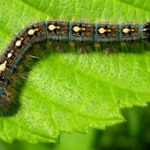 | Tent Caterpillar
-Young larvae are black, mature larvae 12 1/2″ with four yellowishbrown stripes down body containing diamond shaped dots
-Adults are rusty red to pale in color.
-Defoliation of broad leaved trees
-Will affect health and vigor after repeated infestations | -Egg hatch when foliage starts to emerge clustering on silken webs at night
-One generation per year, adults emerge in Late June/ July
-Systemic insecticides, sprays (bio-insecticides available) |
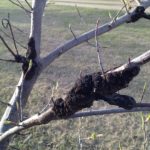 | Black Knot Fungi
-Infects chokecherry, pincherry, wild cherry, cherry and plum trees
-A green swelling appears at first mostly in the fall, as the knots mature they turn black
-Easily spreads and appears on all sizes of branches and twigs
-If the fungus circles the entire branch, it will die, and severly diseased trees may have to be removed altogether | -Caused by a fungus that is spread by wind and rain
-Once it begins growing on a black knot it produces fruiting bodies that spread the disease
-Can also be spread by contaminated pruning equipment
-Can be pruned out if caught early enough |
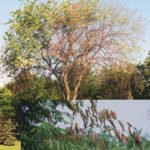 | Dutch Elm Disease
-Vascular infecting fungi that blocks the transport of water and nutrients
-Devastating for Elm trees in North America
-Symptoms include yellow flagging in foliage, browning of leaf tissue (not to be confused with Bacterial Leaf Scorch or Elm Yellowing)
-No standard dieback pattern (this is affected by where the disease was introduced to the tree) | -Arrived in North America in 1930s, it is transferred through root fusion and insects from infected trees such as the Elm Bark Beetle
-Preventative macro injections pre-infection
-Insect control through micro injections will limit insect vector populations – reducing root graft potential in boulevard trees
-Early detection and removal of infected species is crucial.
-Provincial laws regulating disposal of and inoculation of suspected trees |
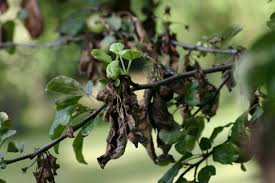 | Fire Blight
-One of the most destructive diseases facing fruit trees
-Tips of twigs form “shephards hook” leaving foul smelling brown foliage retained
-Systemic disease threatens its vascular system and dieback of new growth sometimes causes oozing to drip and spread to lower foliage | -Bacteria overwinter in the bark at the edge of cankers formed during previous growing seasons
-Topical sprays are generally used to reduce effectiveness of re-innoculation from external oozing
-Best controlled through an IPM plan |
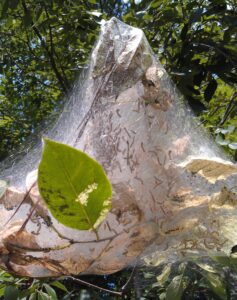 | Fall Webworm
-Affects Schubert Chokecherries, and Apples.
-Worms create silk webs/nests on tips of branches.
-Usually isolated to single branches/stems.
-Caterpillars feed on the foliage that is inside their web. | -Webs can be seen in late summer/early fall.
-Caterpillars lay their eggs on the branches at the end of the fall.
-Due to the insects being inside the webs, broad range insecticides cannot contact the insects.
-Best control is to cut out the nests as soon as they are noticed.
-Early spring Dormant Oil spray to suffocate eggs. |
| | |
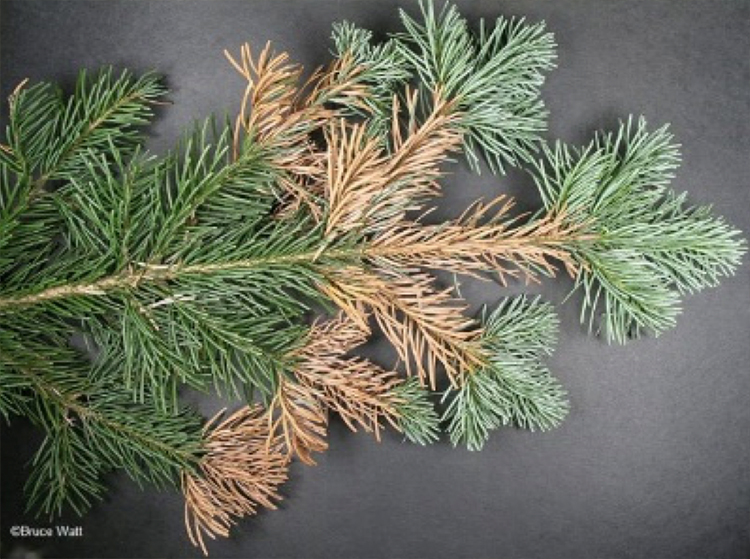 Needle Cast: Needle cast (Rhizosphaera) is a fungal disease that affects spruce trees. it causes the needles to turn brown/purple and fall off. Spruce that are drought-stressed are more susceptible to Needle Cast. Colorado Blue spruce are highly susceptible, but it can also affect White and Norway spruce.
Needle Cast: Needle cast (Rhizosphaera) is a fungal disease that affects spruce trees. it causes the needles to turn brown/purple and fall off. Spruce that are drought-stressed are more susceptible to Needle Cast. Colorado Blue spruce are highly susceptible, but it can also affect White and Norway spruce. Dutch Elm Disease: Dutch elm disease is a vascular wilt disease. The earliest external symptoms of infection are often yellowing and wilting (flagging) of leaves on individual branches. These leaves often turn brown and curl up as the branches die, and eventually, the leaves may drop off.
Dutch Elm Disease: Dutch elm disease is a vascular wilt disease. The earliest external symptoms of infection are often yellowing and wilting (flagging) of leaves on individual branches. These leaves often turn brown and curl up as the branches die, and eventually, the leaves may drop off. 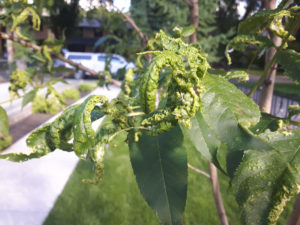 Ash Psyllid: It has over-taken the black ash and Manchurian ash in the City of Saskatoon. Pictured here are the effects the pest has on a leaf essentially, curling it, or “cauliflower-ing” it.
Ash Psyllid: It has over-taken the black ash and Manchurian ash in the City of Saskatoon. Pictured here are the effects the pest has on a leaf essentially, curling it, or “cauliflower-ing” it. 

